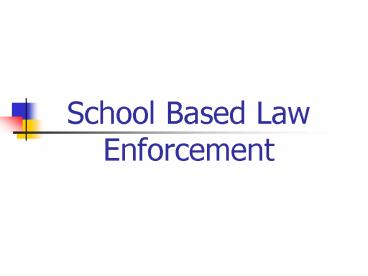School Based Law Enforcement - PowerPoint PPT Presentation
1 / 14
Title:
School Based Law Enforcement
Description:
Sworn law enforcement officers have a positive impact on school climate by ... Identify physical changes in the environment that impact crime and/or safety. ... – PowerPoint PPT presentation
Number of Views:141
Avg rating:3.0/5.0
Title: School Based Law Enforcement
1
School Based Law Enforcement
2
Why Have a Cop at School?
- Sworn law enforcement officers have a positive
impact on school climate by serving in a variety
of roles beyond that of law enforcer - Law-related educator
- Problem-solver
- Community liaison
- First-responder liaison
- Mentor
3
Why Have a Cop at School?
- Identify physical changes in the environment that
impact crime and/or safety. - Promote personal and social responsibility.
- Focus on Quality of life (educational
environment) issues such as - Bullying
- Dating violence
- Chronic misbehavior
- Sexual harassment
- Disconnected students
4
Why Have a Cop at School?
- Immediate Response to Active Shooter, and other
high level violent crimes. - Immediate response to other offenses.
- Immediate response to mental health events.
- Deterrent to intruders, unauthorized persons.
- Deterrent to student violators.
- Deterrent to adult violators
5
Why Have a Cop at School?
- Enhanced communication between schools and the
police. - Identification and prioritization of the most
significant problems. - Development of specific strategies to address the
foremost problems. - Enforcement
- Increased surveillance of crime areas near
schools - Prevention programs addressing gangs, drugs,
violence
6
Integration of LE into Schools
- Establish Collaborative Environment
- Identify Internal and External stakeholders
- Board of Trustees
- Superintendent
- Principals
- Staff
- Students and parents
- Officers, Supervisors, and Command staff of the
Department
7
Integration of LE into Schools
- Select Program Model Many programs center
around the School Resource Officer model that
places an officer at a specific campus utilizing
the triad concept (enforce, teach, mentor) of
service delivery. Others use the more traditional
patrol/response model that focused on
enforcement. Many large school districts use a
combination of both.
8
Integration of LE into Schools
- Define Roles and Responsibilities
- Defined in district policy.
- Involve school administration.
- Involve officers.
- Develop a periodic review process.
- Develop a mechanism for resolving operational
issues. - Develop written job description and allow for
site specific requirements for SROs or other site
based officers. - Cover enforcement, discipline, teaching, and
other responsibilities.
9
Integration of LE into Schools
- Officer Recruitment
- Develop written criteria for officers that
includes - Cares about kids.
- Has temperament to work with school
administrators. - Capacity to work independently.
- Experienced.
- Knows the community.
10
Integration of LE into Schools
- Officer Training
- School based law enforcement training prior to
being assigned to a campus or being turned
loose. - Pre-assignment Training
- Field Officer Training
- In-service Training
- Training with staff/administration
11
Integration of LE into Schools
- Officer Supervision
- Adequate supervision of officers is important to
make sure they are working to their full
potential and are not experiencing unreported or
unacknowledged problems. - SRO supervisors should periodically make site
visits, contact school administrators, and
observe the officers
12
Integration of LE into Schools
- Establish Communications Protocols
- System Level Issues
- Emergency/crisis management
- Personnel
- Facility
- Street Level Officer/Campus/Neighborhood Issues
- School day
- Pre/post school day
- Student
- Staff
- Parent
13
Integration of LE into Schools
- Collaborating with Administrators, Teachers,
Students, and Parents - Departments strategic planning process.
- Developing methods to maintain authority as
enforcers and positive relationship with
students. - Involvement with PTA/PTO.
- Forums for parents and students.
14
Integration of LE into Schools
- Establish Evaluation Process
- Interviews/Observations
- School staff
- Police staff
- Students/Parents
- Documentation of Activity
- Discipline Records
- Calls for Service
- Crime/Incident Reports
- Arrest/Citation Data
- Surveys
- Program Delivery































